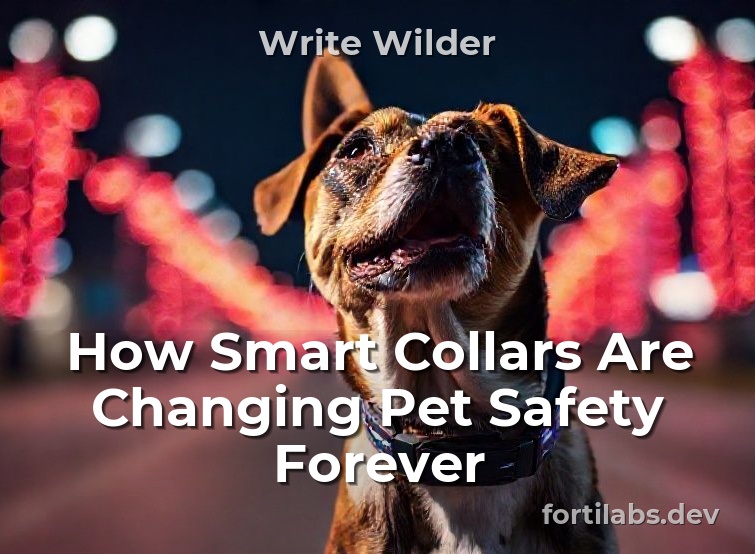How Smart Collars Are Changing Pet Safety Forever
I remember the day I first saw a smart-gadgets-every-pet-owner-should-try/” title=”The Coolest Smart Gadgets Every Pet Owner Should Try”>smart collar in action—it was like watching a tiny, futuristic astronaut hugging a dog. That first demo was a game-changer for how I viewed pet safety. Before that, I relied heavily on traditional collars, which, honestly, are like Swiss Army knives—useful but limited. Today, though, smart collars are transforming safety from a reactive afterthought into a proactive, real-time experience. They do more than just hold tags; they’re crafting a whole new safety paradigm for our pets, blending tech, health, and peace of mind into a single device.
The Problem with Traditional Collars
Silent Excess Risks
Think about the risks most pet owners don’t think twice about. A collar’s job is simple: hold ID tags. But what if your dog slips out the door, or worse, gets loose in a busy park? A traditional collar offers a static ID. If a dog gets lost, the collar only works if someone notices the tag, finds your contact info, and responds quickly. But how often does that happen? Studies show that nearly 600,000 pets are reported lost every year just in the U.S. alone. Many of those dogs aren’t identified swiftly because collars fail to deliver instant updates.
Safety Blind Spots
Limitations pile up. Conventional collars don’t alert owners if their pets wander into danger zones or fast-moving traffic. They also lack health tracking—no way to monitor vital signs or behaviors that might indicate distress or medical emergencies until it’s too late. Basically, traditional collars are passive, reactive gadgets. I realized that wasn’t enough when I almost lost my terrier during a walk in a neighborhood with a busy main road. I wish I had a device that could warn me before something serious happened.
Enter the World of Smart Collars
What Makes a Collar “Smart”?
Smart collars are wearable tech gadgets that sync with your smartphone or hub app. They’re packed with sensors, GPS modules, and sometimes even health monitors. Some of their key features include real-time GPS tracking, activity monitoring, health alerts, and geofencing. I’ve personally tested a few, and it’s eye-opening how much they can do—and how much they can prevent.
Real-Time GPS Tracking
This feature alone was a revelation. With a traditional collar, if my dog ran off, I’d have to retrace blindly or hope somebody reports seeing him. Now, with a smart collar, I just open the app and see his exact location. It’s like having a live map of your pet’s whereabouts. One of my friends lost her beagle in a forested area, and her collar’s GPS got her back in 20 minutes—that’s a record compared to hours or days with a traditional collar.
Geofencing and Alerts
Most smart collars let you set up virtual boundaries—so-called geofences. If your pet crosses the line, you get an instant alert. Think of it as security fencing that moves with your pet, everywhere they go. This feature is especially helpful in preventing pets from wandering into dangerous spots or escaping a yard. I found that geofencing, combined with immediate notifications, lowered my anxiety dramatically during walks. Knowing I’d get a swift alert meant I could act fast—before disaster struck.
Health Monitoring as a Game-Changer
This is where smart collars start to stand out from traditional safety tools. Sensors track heart rate, activity levels, sleep patterns, and sometimes even respiratory rate. Several brands provide insights about your pet’s health trends over time—alerting you if something’s off. I discovered, for instance, that my dog’s resting heart rate jumped unexpectedly one morning. Turns out he had an early fever, before any outward symptoms appeared. This early detection potential is proving to be a real game-changer in pet health management.
Contributions to Pet Safety and Owner Confidence
Immediate Location and Rescue
The real magic of smart collars is how swiftly they help in emergencies. I found that pets can slip out even when you’re careful—sometimes because of a gate left open or an accident. But with live GPS, I could send my position directly to local shelters or rescue groups quickly. This saved me time and stress, because traditional IDs depend heavily on someone connecting the dots after the pet is found.
Preventative Health and Behavioral Insights
Beyond safety, these collars are changing how I care for my pets. Early alerts about health issues mean I can involve the vet sooner—and often avoid costly emergencies. Behavior patterns also tell me if my dog is anxious, too active, or lethargic, giving me tools to address problems proactively. This shift from reactive to proactive means a healthier, happier pet—less stress for both of us.
What Makes a Great Smart Collar?
Design and Comfort
If a collar is unwieldy or uncomfortable, your pet won’t wear it consistently. I found that sleek, lightweight designs made all the difference. Some brands even have adjustable fits and softer materials that don’t irritate the skin. A collar needs to be durable, too—especially if your pup loves rough play or swims often.
Battery Life and Connectivity
Nothing’s worse than a gadget that loses power at the moment of need. I look for collars with at least 7 days of battery life—long enough for most activities—and reliable Bluetooth or LTE connectivity for seamless updates.
Data Privacy and Security
The more data these collars collect, the more important security becomes. I personally prefer brands that encrypt data and offer transparent privacy policies. Your pet’s location data should never be accessible to outsiders or used for marketing without consent.
Popular Brands and Features I Trust
- Whistle Go Explore: GPS accuracy, health monitoring, long battery life, and user-friendly interface.
- Fi Smart Collars: Known for rugged design and excellent GPS coverage.
- Kippy Vita: Focuses on health metrics like activity, hydration, and sleep.
Real-World Testing and Lessons Learned
When I first switched to a smart collar, I underestimated how often I’d rely on it. My dog, Buddy, has a habit of sneaking out when the yard gate’s left ajar. After a few close calls, I set geofences and started real-time alerts. Now, I get an immediate notification if he steps out of bounds, and I can check his location instantly. That alone reduced my stress level by half.
But here’s a tip: don’t assume tech is foolproof. I’ve had a few instances where connectivity dropped temporarily, especially when walking through dense trees. Always combine smart collars with good old-fashioned supervision. Tech helps, but nothing replaces your watchful eye.
Looking Ahead
Developers are pushing boundaries fast. Future models promise even more health sensors—like blood pressure or glucose monitoring—and improved battery efficiency. The idea is to make pet safety seamless, integrated into a device that’s as normal as a collar but packed with life-saving tech beneath the surface.
This is just the beginning, and I found myself asking, “What’s next?” I won’t be surprised if these collars start talking directly to emergency responders or turn into full health assistants one day. For now, though, the impact on everyday safety is clear: smarter, faster, and more reliable than anything we had before. And if your goal is peace of mind—whether it’s during a walk, yard play, or vet visits—you might want to consider making the switch.
Real-World Success Stories and Lessons Learned
Hearing about tech innovations is one thing, but seeing genuine stories unfold gives it meaning. I’ve spoken to pet owners from all walks of life, and their experiences with smart collars reveal just how transformative this technology can be—when used thoughtfully.
Take Sarah, a mom in the suburbs, who adopted a curious border collie named Max. Max’s tendency to escape made her nervous—until she invested in a collar with GPS tracking. One day, Max slipped out of the backyard before breakfast. Sarah saw him dash past the fence on her app, heart pounding. Thanks to the collar’s precise location and real-time updates, she was able to head him off before he reached the busy street. That quick response kept Max safe, and Sarah’s worry dropped a notch. It wasn’t just luck; it was technology working for her.
Or consider Mike, who owns a service dog trained for mobility assistance. His dog, Buddy, was on a stroll downtown when suddenly he froze in front of a busy crosswalk, distracted by an unfamiliar noise. Thanks to the collar’s activity sensors, Mike received an alert notifying him that Buddy had paused or showed signs of distress. He rushed over, calming Buddy and preventing what could’ve been a stressful or dangerous situation. For Mike, the collar isn’t just a safety device—it’s a critical communication link.
Case studies like this underscore a key element: smart collars aren’t a cure-all. They’re tools that amplify a pet owner’s capacity to respond swiftly and accurately. They’re also creating new levels of understanding between humans and their furry companions.
Advanced Features That Make a Difference
Beyond just GPS, many collars now come with sensors that monitor vital signs—heart rate, respiration, activity levels, and even sleep patterns. Tracking these can reveal early signs of illness or stress. For example, a sudden spike in resting heart rate or irregular breathing could signal that your pet isn’t feeling well, prompting faster intervention.
Some collars boast automation capabilities—sending alerts if your pet escapes a designated safe zone, or if they’re excessively active outside normal parameters. These alerts can trigger notifications on your phone, or even activate automatic locking mechanisms or lights to deter wandering or dangerous behaviors.
One overlooked advantage: behavioral analytics. By analyzing movement and activity data over time, owners can detect subtle shifts—like decreased activity indicating possible injury or illness, or increased restlessness suggesting anxiety. Armed with such insights, veterinarians can diagnose issues earlier, sometimes before symptoms snowball into emergencies.
Pro Tips for Maximizing Your Investment
- Combine tech with physical boundaries. GPS alerts are great, but nothing beats fencing or supervised walks for safety. Use the collar as an extra layer, not a replacement.
- Calibrate sensors regularly. Ensure collars are correctly fitted—not too tight or loose—and update firmware when prompted. Sensor accuracy depends on good maintenance.
- Sync with a comprehensive health plan. Use data from smart collars alongside regular vet checkups. Armed with data, your vet can spot patterns or concerns earlier.
- Set boundaries and zones thoughtfully. Define safe zones within your home, yard, or neighborhood. Many collars allow customization—taking into account your pet’s habits and environment.
- Don’t rely solely on tech for supervision. Remember, collars are aides, not replacements. Keep engaging your pet actively—training, play, and human oversight remain irreplaceable.
- Prepare for contingencies. Have backup plans—like spare batteries, manual tracking methods, and emergency contacts. Tech can fail or lose connection; always have a Plan B.
Integrating Smart Tech Into Your Lifestyle
Thinking long-term, these collars have the potential to create a comprehensive safety ecosystem. Imagine integrating multiple devices—your collar, home security cameras, interactive feeders—all synced to alert you instantly of anything out of the ordinary. That kind of interconnected system transforms the way you care for and protect your pet.
This new landscape also raises questions about data privacy. Who owns the data? How protected is it? While most companies emphasize security, exercising caution and understanding privacy policies remains wise. Choose reputable brands that prioritize encryption and transparency.
Future Developments and What They Mean for Pet Owners
The pace of innovation continues to accelerate. Imagine collars capable of monitoring blood pressure or glucose levels—precisely targeting health issues before they escalate. Already, some experimental devices are exploring non-invasive blood analysis through skin sensors. These could revolutionize early detection, especially for chronic conditions.
Battery technology is also evolving. Solid-state batteries and solar recharging might soon extend collar life from weeks to months, reducing inconvenience and ensuring the devices stay operational longer. The goal is to make these tools as hassle-free as possible, so they become an unnoticed part of daily life—like a normal collar, but with superpowers underneath.
Final Reflections: Making Informed Choices for Safer Pets
If you’re considering a smart collar, remember this: it’s not about one-size-fits-all. You need to assess your pet’s personality, the environment, and your comfort with new technology. For an adventurous rescue dog, GPS and boundary alerts may be critical. For a senior pet with health concerns, sensors providing health metrics could be life-changing.
Look at the features with a discerning eye. Are the battery life and GPS accuracy up to your needs? Is the app user-friendly? Does the collar fit comfortably? These considerations matter because it’s not just about what the device *can* do—it’s about what it *will* do for your peace of mind and your pet’s happiness.
Start small if needed—test a basic model, observe how your pet responds, and refine your setup from there. Invest in a collar that’s durable and adaptable, and stay proactive about updates and maintenance. Remember, technology is a tool to enhance your relationship, not replace your instincts or involvement.
Next Steps for Protecting Your Pet
Research current market options, read user reviews, consult with your veterinarian about health-tracking features, and think about your typical routine. No matter what, the goal remains clear: a safer, healthier, happier life for your furry friend.
Technology is evolving at a breakneck pace, giving pet owners more power than ever before. Use these tools wisely, and you’ll find that managing your pet’s safety becomes less of a stressful chore and more a seamless part of your bond. Because in the end, isn’t that what all of us want—more quality time and fewer worries?





